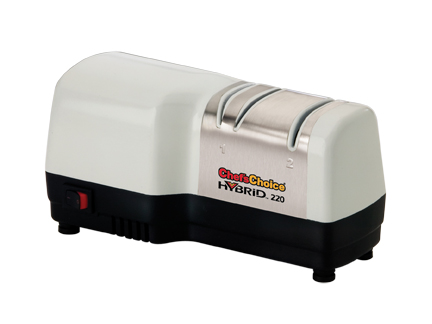Sharpen Up! – Guide to Buying Knife Sharpeners
A blunt knife can be frustrating and potentially more dangerous to use as greater force is required to cut food items. This can result in slippage of the knife, which might lead to cutting your fingers or food bruised by the blunt blade rather than cut into it. With that, knife sharpening is important and doing it wrongly might damage your knife set all together. To ensure your knife set is properly maintained, here are some tips on getting the right knife sharpener.
1) What really happens when your knife dulls
The first thing that goes into most peoples’ minds is that the edge of the knife thickens and becomes blunt over time. In actual fact, the edge of the knife curls over at the top, which is impossible to see with the naked eye. The bluntness that you experience when cutting a knife is actually due to cutting on one side of the knife.
2) Honing Vs Sharpening
Although these two terms are used interchangeably, in the world of knives, they have very different meanings. Honing is the process of straightening out the bent or curved edge. Sharpening on the other hand removes particles of metal from the knife. When your knife is dull, the first step is usually to hone with a steel rod to straighten the blade. If the knife is still dull then it is time to sharpen it. Ideally, you should aim to maintain a good edge on your knives, don’t allow them to get really blunt as it’s harder to get the edge back on a neglected knife.
3) Types of knife sharpeners
Both electric and manual knife sharpeners have their own merits. Many people prefer the control and precision of manual knife sharpening systems. However, modern electric knife sharpeners can be incredibly effective and fast, especially if you’re willing to spend a little more.
Manual
Sharpening stone
Most often rectangular in shape, the sharpening stone may be half to several inches in thickness. There are several different varieties available that are made of a variety of man-made and natural materials like water stones and ceramic. They are available in coarse, medium and fine grit. The coarser the grit the more steel is removed when sharpening. Do take note that although ceramic is made of minerals like stone, it is less porous which provides a smoother more consistent surface for sharpening.
Sharpening steel
This tool is generally made of steel, which is used to re-align the knife’s edge. Running it across the steel will straighten the edge and the knife will be sharp again. It is also used after a knife is sharpened on a stone to remove the debris and any irregularities that may be left on the blade edge. The tool can also be glass, ceramic, or diamond-impregnated metal.
V-shaped knife sharpener
This is a convenient tool to sharpen a knife when a person is not comfortable with using a sharpening stone or steel. The tool’s casing holds two steel rods coated with diamond abrasive or rods made from tungsten carbide that are positioned to form a V-shape that is at a 20° angle for sharpening. One stage is coarser and is used for the first stage of sharpening. The second stage has a finer grind for finishing the sharpening process. The knife’s edge is pulled across the rods when sharpening. Four to six draws of the blade is usually sufficient to keep the blade well-honed. A guard is commonly attached to the sharpener so hands are kept safely away from the knife blades.
Electric
Electric knife sharpener
This sharpening unit contains sharpening wheels or stones that offer a quick alternative for sharpening knives. They have a guide that holds the knife at the perfect angle for sharpening. The sharpening wheels or stones are generally made out of sapphirite, ceramic, or are diamond plated. The blade is drawn through the guided slots a couple of times and the blade is sharpened.
Note that using an electric sharpener on a knife that has a bolster will not allow you to sharpen the heel of the blade. You will not be able to run the entire blade through the sharpener without damaging the heel of the knife.
In addition, be sure to pay close attention to what you are doing because the sharpener will have a tendency to grind more of the blade away than desired. When purchasing an electric knife sharpener, you may wish to opt for one with a diamond dust hone. Diamond dust is very effective at removing metal and is less likely to cause damage to the blade.
4) What to look out for in a good sharpener
Hard abrasive surface: A more abrasive surface would make your sharpening experience less tiring and more precise. Diamond is the hardest followed by tungsten carbide then polish ceramic.
Accurate angle guide: Some sharpeners, especially the sharpening stone kind require more practise to attain the right angle.
Multiple sharpening stages: The coarser surface is for sharpening the knife while the finer surface is for polishing and touch ups.
Safety features: Some sharpeners have safety guards to prevent your fingers from getting cut.

Chef’s Choice® reflects their commitment to create the world’s best professional-quality knife sharpeners and kitchen appliances. Their products are created to perform superbly, last a lifetime and be a pleasure to own.

